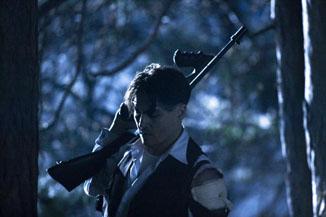Book vs. Movie: Public Enemies
By Russ Bickerstaff
July 8, 2009
To his credit, Mann doesn't go out of his way to tell the viewer what's going on in any given scene. This is something of a relief, as overly expository dialogue can make any historical film feel inauthentic. The problem with this approach is the fact that Mann's script includes scenes that lose their intensity out of context. At one point, Purvis informs an office full of agents that they will be receiving armaments that sound like they belong on a battlefield and offers any of them the opportunity to resign and avoid the danger ahead. The intensity of the scene doesn't come across in the film because it's never really revealed that these people have no substantial law-enforcement background. They started college looking to become lawyers - and when Purvis' desire to work with experienced Texas lawmen is covered a bit in the film, but it's never really explained why. Where Mann has included some of these details from the book, they get lost in the overall picture.
When framing the story, Mann focuses more time on Dillinger than the Bureau and the movie suffers a bit as a result. While much of the film strives to be as journalistic as the book, Mann's film is a romance at heart. We see Dillinger falling in love with the French-Menominee woman Billie Frechette (Marion Cotillard) which was, at best, a minor supporting detail in the overall picture of the man. The film not only focuses on romance, but is an inherently romantic look at the life of a ‘30s bank robber. Some of this comes across beautifully. Depp moodily portrays moments in the life of a man in a troubling occupation. It's all very stylish, and looks distinctly unlike any other big budget film to make it into wide release over the course of the past decade or so. A lot of this has a lot to do with the fact that so many of the exterior shots were filmed on location in Wisconsin. Rarely host to camera crews, the unique appearance of vintage buildings and country back roads found in that specific area of the Midwest rarely gets seen in a medium that is so completely infatuated with New York and LA. Okay, so I happen to LIVE in Wisconsin and am probably a bit biased here, but many key moments in the life of Dillinger DID happen in the state and it's nice to see the film be faithful to that much of Dillinger's life.
Perhaps the biggest opportunity Mann missed here was an opportunity to show the man's unrealistic belief in the redemptive power of identity-altering plastic surgery. Looking over this aspect of the man's life, which was arguably the real thing that got him in the end, amounts to something of a fragmented image that ends up being little better than a stylish update of the 1930s gangster films - fun and romantic when it could've been so much more.
The Verdict
While the book can be boring and repetitious in places, it does so in the interest of showing a complete, reasonably comprehensive look at the events in question. The details of the subject matter that are often overlooked are given startling space to breathe that make the repetition of bank robbery after bank robbery seem relatively unimportant. The book's prose style delivers even the repetition with a careful hand. Mann's film adaptation of the Dillinger portions of the novel lacks the details that make the book such an idiosynchratic masterpiece, but it's a stylish update on the standard ‘30s gangster film that could attain solid success at the box office this summer. Had the film possessed the kind of vision that the novel did in taking a skewed perspective on the offbeat avenues of the subject matter, it may have run the risk of being a financial failure, but it could've also been just offbeat enough to serve as fascinating counterprogramming and one of the biggest successes at the box office this year. Instead, we get a solid, profitable film that mixes action and romance in the ‘30s.
Continued:
1
2
3
|
|
|
|




